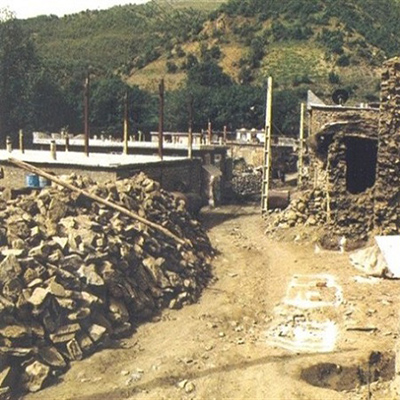Sites
Alvatan
Written by: Fatemeh Khademi
Translated by: Hadi Qorbanyar
10 Views
Alvatan is a village in the Sardasht district of West Azerbaijan Province. It was a key area during the Iran–Iraq War due to its rugged terrain and the presence of anti-revolutionary elements in its surrounding highlands.
Alvatan lies in the northwestern part of Sardasht County, at the southwestern edge of West Azerbaijan Province and the northwestern tip of Kurdistan Province,[1] right along the Iran–Iraq border.[2] The area is surrounded by dense woodlands known as the Alvatan forests, with many mountain ridges nearby.[3] Kurdish-speaking people live in this region and its surrounding villages.[4]
Following the victory of the Islamic Revolution, the Alvatan forests—with their thick, interwoven trees, steep cliffs, and dangerous mountains—became a natural fortress for anti-revolutionary groups to hide and launch ambushes.[5] These forests stretch along the road connecting Baneh (in Kurdistan Province) to Sardasht (in West Azerbaijan).[6] Armed separatist groups, such as Komala and the Democratic Party, created bases in the Alvatan forests and nearby villages, especially in the Dolatoo area.[7] These included political offices, detention sites for hostages, and other affiliated facilities. Using the valleys between the forested peaks, their fighters moved back and forth across the border with Iraq, transporting personnel, weapons, and supplies.[8] On August 24, 1979, they attacked the Sardasht gendarmerie outpost, seized the Iranian border base, and looted its equipment.[9]
For four years—from 1979 to 1982—the Alvatan forests remained under anti-revolutionary control.[10] Fierce clashes broke out between insurgents and Iranian forces as they tried to clear the roads and surrounding heights. For instance, on October 24, 1979, when delivering supplies to the units in Alvatan, the Iranian troops were ambushed near a valley. As a result, nine Iranian Army personnel were martyred, and one military vehicle was destroyed.[11]
With the onset of the Iran–Iraq War, armed members of the Democratic Party began collaborating with the enemy. They took members of the Islamic Revolutionary Guard Corps (IRGC), the Army, the Jahad-e Sazandegi Organization, and other supporters of the Islamic Republic hostage, holding them in a site known as the Dolatoo prison in Alvatan. They were later martyred in an air strike carried out by the Baathist aircraft in coordination with the Democratic Party.
In 1981, Iran expanded its military footprint in the Kurdistan region and successfully cleared the area of Komala and Democratic Party elements, who fled across the border into Iraq. Coordinating with the Kurdistan Democratic Party of Iraq, the Patriotic Union of Kurdistan, and Muslim Kurdish Peshmerga fighters, and by establishing the Hamzeh Seyyed al-Shuhada Headquarters in the region, Iranian troops successfully dismantled the operational capabilities of the Democratic Party of Iranian Kurdistan.[12]
To counter anti-revolutionary activity in the northwest and liberate occupied territories, the Special Martyrs Brigade was formed by Muhammad Boroujerdi (martyred) and Nasser Kazemi (martyred), with Mahmoud Kaveh (martyred) appointed as its operations commander. One of the brigade’s most significant missions under Kaveh’s leadership was the Battle of Alvatan. The goal was to liberate the strategic border corridor between Piranshahr and Sardasht in southwestern West Azerbaijan Province. The operation began in May 1982 and continued through October of that year.[13]
The main focus was reclaiming the highlands of Alvatan, which had become a political and military stronghold for anti-revolutionary forces. Mahmoud Kaveh played a central role in the operation, especially after the martyrdom of the brigade’s first two commanders, Nasser Kazemi and Muhammad Ganjizadeh, during the early phases. The operation was executed in sixteen stages across three months. It resulted in the liberation of the Piranshahr–Sardasht corridor, reclamation of strategic highlands and forests in Alvatan, destruction of anti-revolutionary command centers and radio installations, and the capture of large quantities of equipment. Also, over 750 enemy troops were killed, and more than 120 kilometers of roadway were freed. The operation was a major success in the fight against insurgents, though foreign radio outlets attempted to undermine its significance with a wave of false reports and accusations.[14]
As the clearing operations continued, Iranian units stationed in Piranshahr (located between western and southwestern West Azerbaijan, north of Sardasht near the Iraqi border), Haj Omran (a town in Iraq’s Erbil Governorate near the Iranian border), Sardasht, and Alvatan. On March 2, 1984, they launched heavy artillery strikes on enemy positions, which seriously damaged the enemy troops and prevented further reinforcements from reaching the area.[15]
The efforts to clear the highlands of the Alvatan forests and the Baneh–Sardasht Road of anti-revolutionary forces continued in several phases. The first was Operation Nasr, launched at midnight on July 18, 1984, in coordination with the Hamzeh Seyyed al-Shuhada Headquarters. The goal was to liberate villages in the Alvatan region and secure the border mountains. It was carried out across three axes. The first axis, led by Nasser Safarzadeh, southward from the Alvatan junction on the Piranshahr–Sardasht Road; the second, under Mahmoud Kaveh’s command, from Mirabad toward the south; and the third, led by Ali-Reza Askari, from Bivaran toward the north.
As the operation began, the anti-revolutionary observers positioned on the surrounding heights detected the advancing IRGC and Army units and reported their positions. Therefore, senior commanders and core fighters fled across the border into Iraq, leaving lower-ranking militants to resist the Iranian advance. The operation lasted 13 days, during which 16 villages were cleared and key mountains were retaken by Iranians.[16]
Later that summer, a Komala battalion infiltrated the Alvatan region, destabilizing villages that lacked military outposts and launching attacks on several Iranian positions. To restore security, the Hamzeh Seyyed al-Shuhada Headquarters tasked the 110th Shahid Boroujerdi Brigade with leading a joint operation together with a battalion from the 23rd NOHED Division of the Army and a mountain infantry unit from the IRGC in Sardasht. Subsequently, Operation Fajr was launched on September 9, 1984, from three directions: from Vavan toward Aghlan, Nochavan, and Ahmadboro; from Vavan toward Bardeh-Sour; and from Vavan toward Sarshiv, Divalan, and Aashaddin. When they saw Iranian units, Komala forces withdrew, allowing Iranian troops to enter the villages without resistance. However, one Komala group ambushed a unit of the 23rd NOHED Division, resulting in the martyrdom of six Iranians.[17]
After 1984, the region experienced relative stability until the end of the war. One of the darkest chapters came in 1987, when Iraq launched a chemical attack on Sardasht, which resulted in the martyrdom of 130 people and injuries to 8,025. Many survivors still suffer from the long-term effects of chemical exposure.[18]
[1] Sadeqi, Reza, Atlas-e Rahnama 12– Azarbayjan-e Gharbi dar Jang ba Zed-e Enqelab va Defa Muqaddas (Atlas 12– West Azerbaijan in the War against anti-revolutionaries and the Sacred Defense), Tehran, Markaz-e Asnad va Tahqiqat-e Defa Muqaddas Sepah-e Pasdaran-e Enqelab-e Eslami, 1391, Pp. 66 and 154.
[2] Ahmadi, Batoul, Moama-ye Dolatoo (Dolatoo Puzzle), Isfahan, Setargan-e Derakhshan, 1392, p. 7.
[3] Sadeqi, Reza, Ibid., p. 154.
[4] Ibid., p. 22.
[5] Mousavi, Saeed, Nabard-e Alvatan (Battle of Alvatan), Mashhad, Kongere-ye Bozorgdasht-e Sardaran-e Shahid-e Ostan-e Khorasan, 1379, Pp. 26, 27 and 52.
[6] Ibid., p. 27.
[7] Ahmadi, Batoul, Ibid., p. 7.
[8] Sadeqi, Reza, Ibid., p. 154; Mousavi, Saeed, Ibid., p. 27.
[9] Mousavi, Saeed, Ibid., p. 66.
[10] Ibid., p. 72.
[11] Amirnazmi Afshar, Manouchehr va Esfandiar Hajilo, Tarikh-e Moaser-e Azarbayjan – Azarbayjan-e Gharbi dar Gozaar az Bohran-ha-ye Enqelab-e Eslami va Jang-e Tahmili, (Contemporary History of Azerbaijan – West Azerbaijan Amid the Crises Arising during the Islamic Revolution and the Imposed War), Vol. 1, Tehran, Sureh-ye Sabz, 1395, p. 257.
[12] Daireh-ol-Maaref-e Enqelab-e Eslami (Encyclopedia of the Islamic Revolution), Vol. 2, Tehran, Daftar-e Adabiyat-e Enqelab-e Eslami, Sureh-e Mehr, 1384, p. 94.
[13] Sadeqi, Reza, Ibid., p. 90; Vaezi, Moradali va Somayeh Eqbali-Nasab, Delirmardi az Diyar-e Khorasan (A Brave Man from the Land of Khorasan), Birjand – Sepah-e Pasdaran-e Enqelab-e Eslami (Khorasan Jonoubi), Farmandehi-ye Sepah-e Ansar-al-Reza,1394, Pp. 36 and 37.
[14] Vaezi, Moradali, Ibid., Pp. 36–39, 71.
[15] Shahriar Naqipouran va Digaran, Tarikh-e Moaser-e Azarbayjan – Azarbayjan-e Gharbi dar Gozaar az Bohran-ha-ye Enqelab-e Eslami va Jang-e Tahmili (Contemporary History of Azerbaijan – West Azerbaijan Amid the Crises Arising during the Islamic Revolution and the Imposed War), Vol. 2, Tehran, Sureh-ye Sabz, 1395, p. 666.
[16] Sadeqi, Reza, Ibid., p. 154.
[17] Ibid., p. 138.
[18] Site-e IRNA (IRNA Website), 8 Tir 1401 / Code Khabar: 84806086.





